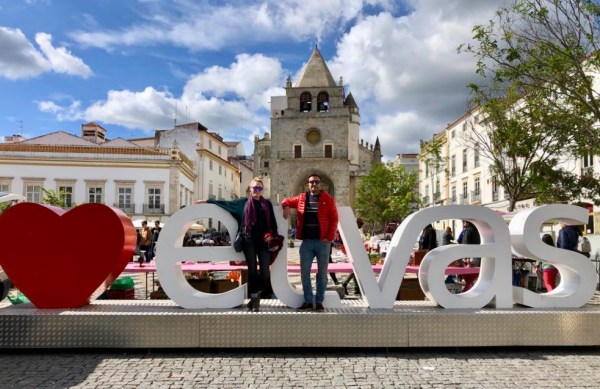I’ve just returned from a road trip through Extremadura with my family. We planned our visit during Holy Week (Easter) and were able to see religious processions in several different cities. The weather is unpredictable in spring but we got lucky with clouds and cool temperatures—perfect for exploring! The trip lasted 4 days, 3 nights and we visited 5 cities along the way. It was the perfect amount of time to see the main attractions of each destination and the distance between each stop ranged from 30 minutes to 3 hours.

Quick tips
- This blog provides the itinerary of our trip—I suggest visiting the cities in this order if you’re heading up from Seville. This way you won’t spend too much time in the car between cities.
- Extremadura is known for its delicious cheese (Torta del Casar) and Iberian ham (jamón) and I strongly encourage you to eat as much as possible while you’re there. 😉
- Keep in mind you’ll need cash and small change when visiting this region—most historical sites and churches charge an entry fee of €1 – €2. They also provide youth, student, and senior discounts so make sure to take advantage of this if you’re eligible.
Mérida, Spain
We left Sanlúcar in the morning and drove 3 hours to Mérida—the capital of Extremadura. The city was founded in 25 BC by Augustus Caesar as a place where his soldiers could retire to. Mérida was originally called Emerita Augustand is still home to extraordinary Roman ruins. Upon arriving we ate lunch at Trece Uvas (while enjoying views of Temple of Diana) and ventured out to explore the city on foot.

You won’t want to miss the world’s longest Roman bridge, the Temple of Diana, the Alcazaba, Aqueduct of Miracles, the Circus Maximus (1st century BC), Amphitheatre, and Roman theatre. We spent four hours sightseeing in the center and stopped by the aqueduct on our way out of town towards Trujillo.

Trujillo, Spain
We arrived in Trujllo from Mérida after an hour and checked in to our rooms at Hotel Izan Trujillo. The hotel has a beautiful interior patio and its location is within walking distance of all the city’s attractions. Our favorite sites were the Castillo Árabe, Pizarro House Museum (conquistador who led Spanish conquest of the Inca Empire) and climbing the tower in Santa Maria la Mayor Church.


We headed to the main plaza around 8pm to grab a seat at El Medievo so we could watch the Easter processions while we ate dinner. The next morning we headed to Cáceres in time for lunch after exploring the Trujillo’s castle in the morning.

Cáceres, Spain
After a short 30 minute drive we arrived in Cáceres and checked in to our rental apartment. The apartment was nice but if you’re traveling as a family make sure you’re getting one of the larger apartments that provide separation between bedrooms.
Cáceres was founded in 25 BC by the Romans and after the fall of the Roman empire it was occupied by the Visigoths, and later by the Arabs. The city was declared a UNESCO World Heritage Site in 1986 because of its extraordinary blend of Roman, Moorish, Northern Gothic and Italian Renaissance architecture. There is a lot to see in Cáceres and our favorite sites were the Golfines Palace, Torre de Bujaco, Arco de Estrella, Plaza Mayor, the Jewish Quarter, and the co-cathedral.

There are free tours available in Cáceres, but I would recommend booking a private tour in the morning (ex. 9:30am). Most tourists start to appear around 11am and you’ll have all the sites to yourself! We booked our English tour for €10 each at the Turismo Singular office in the main plaza. Also, we really enjoyed the food and outdoor seating at Minerva in the main plaza (you might need to make a reservation if you want to eat there).

Elvas, Portugal
In the morning we drove 1.5 hours from Cáceres to Elvas, Portugal. Elvas is a Portuguese city-fortress located 8 miles from the Spanish border. The town’s main attractions are its massive, star-shaped fortresses—the Nossa Senhora da Graca and Sainta Luizia Fort—but don’t miss out on the main square, castle, Ascension church, and impressive aqueduct. We stayed at our favorite hotel of the entire trip, Hotel Sao Joao De Deus, an old monastery converted into an adorable boutique hotel.



The food in Portugal never disappoints! You can pay €7 for a ‘jarro’ (pitcher) of local wine and make sure to order a plate of bacalhau dourado (or bacalhau à brás) at least once while you’re in the country. Check out Restaurante Girassol for a small, family owned restaurant serving up delicious home cooked meals for a great price. Also, don’t be surprised if you’re asked to share your table with other guests (the restaurant is tiny so people have to share tables). I also recommend making a reservation at Adega Regional—we loved the ambiance, service, food, and the dessert was fantastic too!

Zafra, Spain
On our way back to Sanlúcar we stopped by the Parador in Zafra for lunch, which is just a 1 hour drive from Elvas. It’s a beautiful little town and a convenient stop on the road between Cáceres and Seville.

After lunch we explored the city with a detour down Calle Sevilla for shopping. Zafra’s main attractions include the castle, Plaza Grande, Plaza Chica, Arquillo del Pan, Casa del Ajimez, Monastery of the Encarnación (16th century) and Church of the Candelaria.
Thanks for sharing your trip. You’ve given me some ideas.